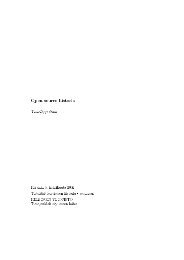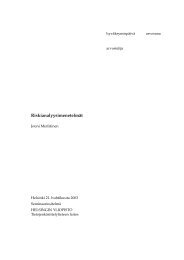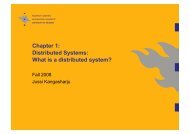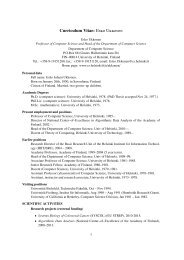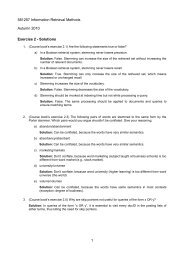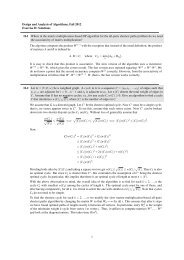Calculating trust in sensor networks
Calculating trust in sensor networks
Calculating trust in sensor networks
You also want an ePaper? Increase the reach of your titles
YUMPU automatically turns print PDFs into web optimized ePapers that Google loves.
more detailed monitor<strong>in</strong>g scheme will more likely detect different k<strong>in</strong>ds of attacks.<br />
A <strong>trust</strong>-based rout<strong>in</strong>g-algorithm might only use first-hand observations (direct <strong>trust</strong>) about<br />
it neighbours or it might gather third-hand observations (<strong>in</strong>direct <strong>trust</strong>) from other nodes.<br />
Indirect <strong>trust</strong> adds another layer of complications as the observations can also be from<br />
un<strong>trust</strong>ed nodes. Some protocols do not employ <strong>in</strong>direct <strong>trust</strong> at all, while some weigh<br />
recommendations aga<strong>in</strong>st what is known about the recommender. Some protocols also<br />
use active notifications <strong>in</strong> situations where they discover an un<strong>trust</strong>worthy node. These<br />
notifications usually warn other nodes about a bad node.<br />
The follow<strong>in</strong>g details different <strong>trust</strong>-based rout<strong>in</strong>g protocols, their components, how they<br />
def<strong>in</strong>e <strong>trust</strong> and how they monitor their surround<strong>in</strong>gs along with details about how <strong>trust</strong><br />
is used <strong>in</strong> rout<strong>in</strong>g decisions.<br />
3.2 Confidant<br />
Confidant [BB02] is a distributed <strong>trust</strong> manager that cooperates with the rout<strong>in</strong>g layer.<br />
Confidant is based on the Dynamic Source Rout<strong>in</strong>g protocol (DSR). Confidant consists<br />
of 4 components: the monitor, the <strong>trust</strong> monitor, the reputation system and the path<br />
manager.<br />
The monitor is <strong>in</strong> charge of notic<strong>in</strong>g unwanted behaviour <strong>in</strong> neighbour<strong>in</strong>g nodes and it<br />
reports deviations to the reputation system. The reputation system ma<strong>in</strong>ta<strong>in</strong>s a list of<br />
nodes and their reputations. The system changes a nodes reputation only when the moni-<br />
tor notices significant bad behaviour that occurs for a long period of time. The reputation<br />
system then modifies the reputation for the node depend<strong>in</strong>g on the type of bad behaviour<br />
that was monitored.<br />
The <strong>trust</strong> manager component sends out and deals with ALARM-messages. These mes-<br />
sages are used by nodes to notify about un<strong>trust</strong>worthy nodes. An ALARM-message def<strong>in</strong>es<br />
the type of misbehaviour that was noticed, how long this has occured and which node is<br />
<strong>in</strong> question. A node will send out and ALARM when it observes or is alarmed by an<br />
un<strong>trust</strong>worthy node. To deal with false messages, Confidant uses a sort of friends list<br />
20




